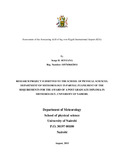| dc.description.abstract | This research work reviews forecasting for fog, in general, and particularly it focuses on methods used to forecast, accuracy of the forecast and occurrences of fog. Performing time series and skills analysis help us to link the weather pattern and how the weather behaves in relation to fog. Although fog is hard to forecast but one can maximize the accuracy. Normally, forecast will be used by pilots and the personnel at the KIA (Kigali International Airport) but also by RTDA (Rwanda Transport Development Agency) and will be used to prevent people from accidents; and good decision making for air routes and nearby ground routes. For instance, for aviation industry, we require cloud bases and these are near the ground when fog has occurred and so we need to estimate how high “is the cloud base above the ground”. In addition, forecasts are done in such a way that it can be reliable for the schedule and safety of the public (especially in aviation industry). At the KIA; the crucial challenges faced the forecast of visibility and observation when the visibility is poor; especially during mornings can be less than 100m (fog). When it is foggy; pilots will not see (or not clear) the runway and so will choose to delay flights until fog clears, or to shift to a nearest airport or even worst to cancel the flight schedule (the flight plans are set according to information about weather and forecasts; by also taking into account what weather hazard is likely to happen). The techniques used to forecast fog varies widely, and the KIA which is mostly affected by radiation fog; are using information about the cloud, temperature, humidity and wind by considering the season of the year; mostly they occur in the wettest season which is from March to May also known as MAM, and less occurrences of fog in the transition season of SOND (September to December) with the highest frequency in April, March and December due to enhancement in rainfall resulting in topography of the country (Kaligirwa, 2013). By information on what was forecasted (about fog) and what really happened, we will determine whether we need to improve on our forecast and how to correct an error (from observation, through forecasting, to transmission and storing information) Peer reviewed journals and papers; advised verification as effective on improvement forecasting, and so we are choosing this method to help improve forecast of fog at the KIA | en_US |

